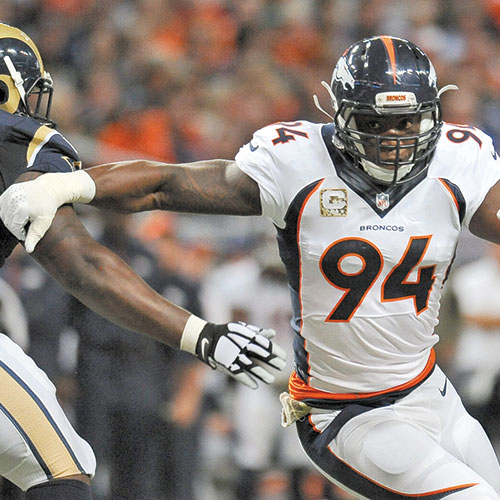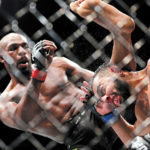NFL pass-rushers turn to martial arts tactics

By ARNIE STAPLETON | AP Pro Football Writer
DENVER (AP) — Denver defensive end DeMarcus Ware considers himself a mixed martial artist on the football field.
Ever since his rookie year in 2005, he’s spent as much time in the offseason working on his handwork with a second generation Bruce Lee student as he has working out at a traditional gym.
Ware is part of a growing number of NFL pass rushers who have adopted the grappling and striking techniques of MMA. It helps them outmaneuver the ever-expanding 330-pound tackles and get to the ever-quicker quarterbacks before they can throw the football.
Ware credits the moves he’s learned and refined under the tutelage of Valentin Espiricueta, owner/operator of AppliedMMA in Dallas, for helping him amass 127 sacks over his decade in the NFL.
“If I didn’t learn martial arts, I’d be just a basic dip-and-rip guy just trying to go around the corner,” Ware said.
Instead, Espiricueta’s star pupil and eight-time Pro Bowler uses swift swipes and whirlwind motions to set up and ultimately vanquish pass protectors. Like a fighter getting the best of his opponent in the octagon.
Sparring or grappling with technical fighters and their trainers teaches NFL players to swat away and otherwise avoid punches from O-linemen. It also aids their cardiovascular training, tenacity and acumen.
“What we’re doing at least in the grappling aspect of our sport is we’re manipulating another man’s body, putting it where we want it, whether that’s putting it on the ground or moving it to the left or right or off-balance,” said Matt “The Immortal” Brown, a 33-year-old welterweight UFC fighter from Columbus, Ohio. “So, to learn how to control another man’s body is surely going to be an important skill for them. Anytime it’s one on one, man against man, there’s going to be some correlation.”
Packers pass rusher Datone Jones said MMA training helps his “hand-eye coordination, balance, body control and just being able to strike, being able to endure more.” The ancillary benefit, he said, is greater flexibility, “so it’s working on more areas so you get stronger, flexible, faster, looser.”
Vikings pass rusher Brian Robison said mastering MMA techniques and transferring them to the football field “allow you to rush the passer a little bit easier.”
Ware was introduced to the martial arts aspect of pass rushing by Greg Ellis, a defensive end in the NFL from 1998-2009. Ellis learned of Espiricueta’s training methods from Randy White, who played for the Cowboys from 1975-88.
“Greg Ellis told me, ‘You’re not going to have this speed forever. But you can have the quickness.’ So, one thing I learned when I did have a lot of ability, like Von Miller, was I would actually just beat guys from here,” Ware said, tapping his right temple, “instead of beating them just with athleticism.”
Espiricueta combined the Filipino martial art known as Kali with the Bruce Lee style of Kung Fu known as Jeet Kune Do, or JKD. Practitioners of JKD believe in smooth, minimal movements and with maximum effects and extreme speed. It is referred to as “the art of fighting without fighting.”
Espiricueta, who studied under Bruce Lee student Dan Inosanto, has worked with numerous NFL players, but said Ware “took it to a different level.”
He developed a training program customized for football players in response to the league’s rule change in 1978 that allowed offensive linemen to open their hands and leave their arms extended rather than use the hit-and-recoil techniques like boxers.
“It was all about the hands and how to get their hands off you,” he said.
That rule change led to a transformation in the trenches as O-linemen ballooned past 280, 290 and then 300 pounds, overpowering defenders by sheer size. Nowadays, they’re typically 330 pounds and outweigh most defensive ends by 75 pounds and linebackers by 100.
So defenders either have to be fast enough to get around them or quick enough to swat away their hands when they punch.
A dip-and-rip or jab step just doesn’t always do the trick anymore. But with martial arts techniques, “you figure out what’s the best leverage point and he can be 350 pounds and it doesn’t matter, you’re going to beat him,” Ware said.
“It’s like a chess match. You’ve got to be patient,” Ware said. “Because if you beat him just three times and have three sacks in that game, you had a monster game.”











